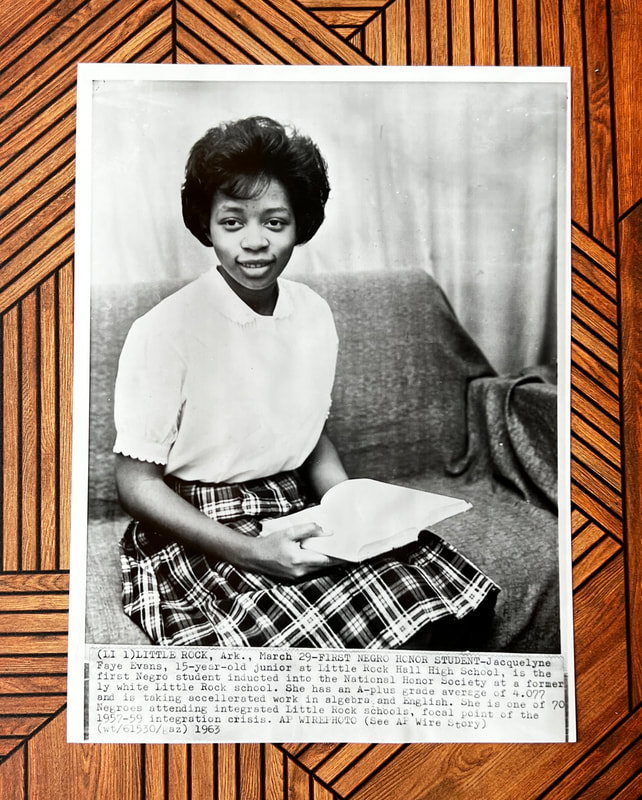CR263
March 29, 1963 Press Photo
Jacquelyne Faye Evans, first black honor student
Little Rock Hall High School - Little Rock, AR
On May 17, 1954, the U.S. Supreme Court ruled in Brown vs. Topeka Board of Education that segregated schools are "inherently unequal." In September 1957, as a result of that ruling, nine African-American students enrolled at Central High School in Little Rock, Arkansas. The ensuing struggle between segregationists and integrationists, the State of Arkansas and the federal government, President Dwight D. Eisenhower and Arkansas Governor Orval Faubus, has become known in modern American history as the "Little Rock Crisis."
The crisis gained world-wide attention. When Governor Faubus ordered the Arkansas National Guard to surround Central High School to keep the nine students from entering the school, President Eisenhower ordered the 101st Airborne Division into Little Rock to insure the safety of the "Little Rock Nine" and that the rulings of the Supreme Court were upheld. The manuscript holdings of the Eisenhower Presidential Library contain a large amount of documentation on this historic test of the Brown vs. Topeka ruling and school integration.
6 years later in 1963 Jacqueline Faye Evans was inducted into the National Honor Society at Hall High School in Little Rock. When Hall High School opened in 1957, it was part of a plan to stall school integration in Little Rock. Anticipating change under Brown, Superintendent Virgil Blossom and the School Board opened the all-black Horace Mann High School in what was mostly black East Little Rock in 1956. Hall was built a couple of blocks west of University, in what was then an affluent white neighborhood in West Little Rock.
Under Blossom’s token desegregation plan, in 1957, white students could opt out of attending Horace Mann, but black students didn’t get the option of attending Hall. Although three black students enrolled at Hall in 1959, residential housing patterns preserved de facto segregation at Hall until court-ordered busing began in 1971.
The crisis gained world-wide attention. When Governor Faubus ordered the Arkansas National Guard to surround Central High School to keep the nine students from entering the school, President Eisenhower ordered the 101st Airborne Division into Little Rock to insure the safety of the "Little Rock Nine" and that the rulings of the Supreme Court were upheld. The manuscript holdings of the Eisenhower Presidential Library contain a large amount of documentation on this historic test of the Brown vs. Topeka ruling and school integration.
6 years later in 1963 Jacqueline Faye Evans was inducted into the National Honor Society at Hall High School in Little Rock. When Hall High School opened in 1957, it was part of a plan to stall school integration in Little Rock. Anticipating change under Brown, Superintendent Virgil Blossom and the School Board opened the all-black Horace Mann High School in what was mostly black East Little Rock in 1956. Hall was built a couple of blocks west of University, in what was then an affluent white neighborhood in West Little Rock.
Under Blossom’s token desegregation plan, in 1957, white students could opt out of attending Horace Mann, but black students didn’t get the option of attending Hall. Although three black students enrolled at Hall in 1959, residential housing patterns preserved de facto segregation at Hall until court-ordered busing began in 1971.



